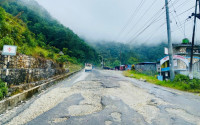Gandaki Province
Tanahu folk hold puja to prevent leopard attacks
Locals believe they are on the receiving end of the almighty’s wrath.
Samjhana Rasaili
As leopards continue to enter human settlements, locals in Tanahun have been scrambling to find measures to contain the animal. The locals had even used wooden snares, a traditional measure, to trap wild animals. But this too hasn’t been as effective as expected.
The agitated locals have now concluded that the leopard incursion is the result of goddess Devi’s wrath. As a remedy, locals from wards 1, 2, 3, and 4, on Tuesday, performed a puja at the Thakrek Kalika Devi temple in Nareswhartar to appease the Devi.
Read: This is why leopards are entering our cities
“Since all measures have failed, we figured the Devi was unhappy with us,” said Seeta Adhikari, a local from Bhanu Municipality-2. In the municipality’s ward numbers 1, 2, 3 and 4, leopards have killed six children and 70 cattle and injured seven people in the past two years.
Two hundred fifty households participated in the puja for which two goats were sacrificed.
“This kind of puja is typical of Chaite Dashain (a festival celebrated in April), but we suspected that the procedures were not proper in last year’s festival,” Adhikari said. “So we are trying to correct that with this puja.”
“We are hopeful that this puja will help dissuade leopards from entering our settlements,” said Prem Bahadur Thapa, another local. “It’s done according to our beliefs and religion. But we also believe that advanced measures should be taken to control leopard attacks.”
Among other measures, nine traditional wooden cages have been built in community forests around Bhanu Municipality. The cages have trapped two male leopards so far. Officials at the District Forest Office said the exact number of leopards in the forest hasn’t yet been ascertained.
Maya Manandhar, another local, said the frequent incidents of leopard attacks have affected the villagers’ lifestyle. “These days, the villages turn silent as soon as five in the evening,” Manandhar said. “And the lights are on throughout the night.”
Kedar Baral, chief of the Division Forest Office, said the office has set up various measures such as ‘foot trap’, ‘camera trapping’, and traditional cages to trap leopards.
Gandaki Province has allocated Rs3 million to contain leopard menace in Tanahun. “We are preparing to deploy a team to capture leopards,” said Kiran Gurung, acting chief minister of Gandaki province.
Over the years, the cases of leopards entering the human settlement, especially in Kathmandu valley, have increased. As urban Kathmandu continues to expand, it encroaches more and more on the surrounding forests—the habitat of the leopard. This is the primary reason behind such recurring leopard excursions, say wildlife conservationists and national park officials.
An estimated 66 percent of their range in Africa and 85 percent in Eurasia—the two regions of the world where leopard populations thrive—have been destroyed over the past five decades. In many areas around the world, the only alternative left for these big cats is to attempt to survive alongside humans.
“Despite inhabiting a huge area, from across the country’s Tarai to the mid-hills at around 800 metres to 3,000 metres above sea level, the leopard is one of the least studied animals in the country,” Laba Guragain, national park ranger at the Shivapuri-Nagarjun National Park, had told the post on June, 2019.




 14.12°C Kathmandu
14.12°C Kathmandu










